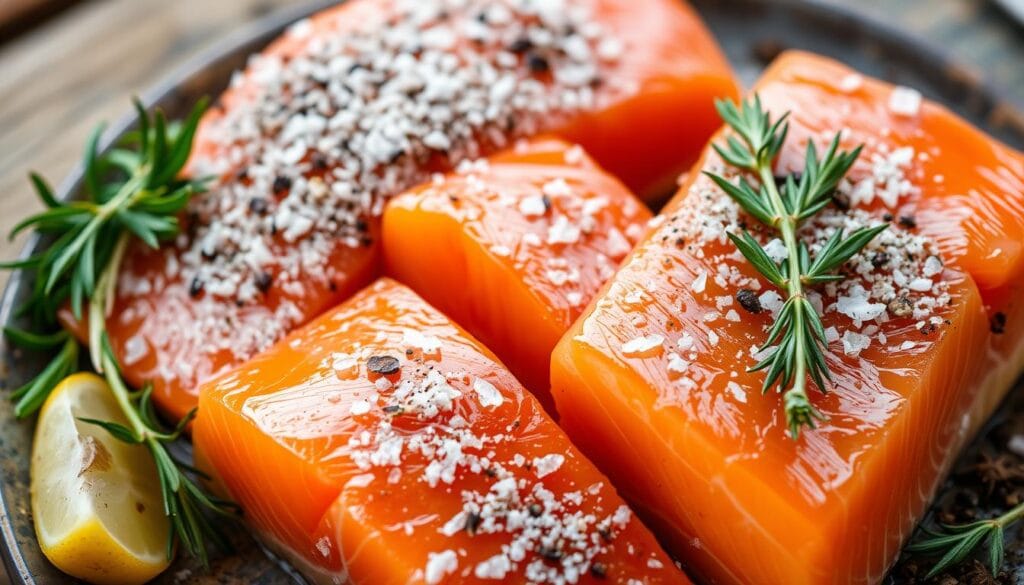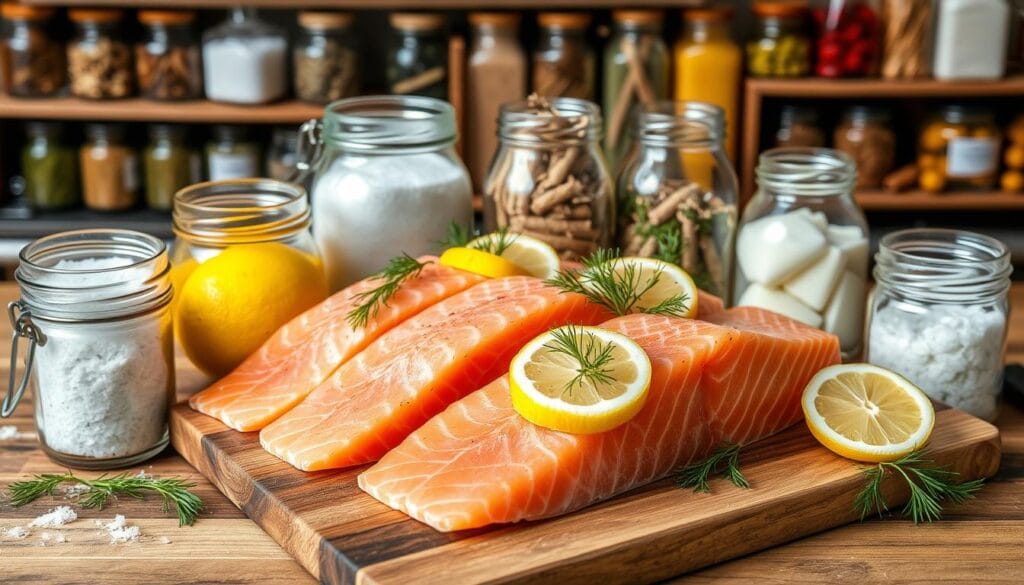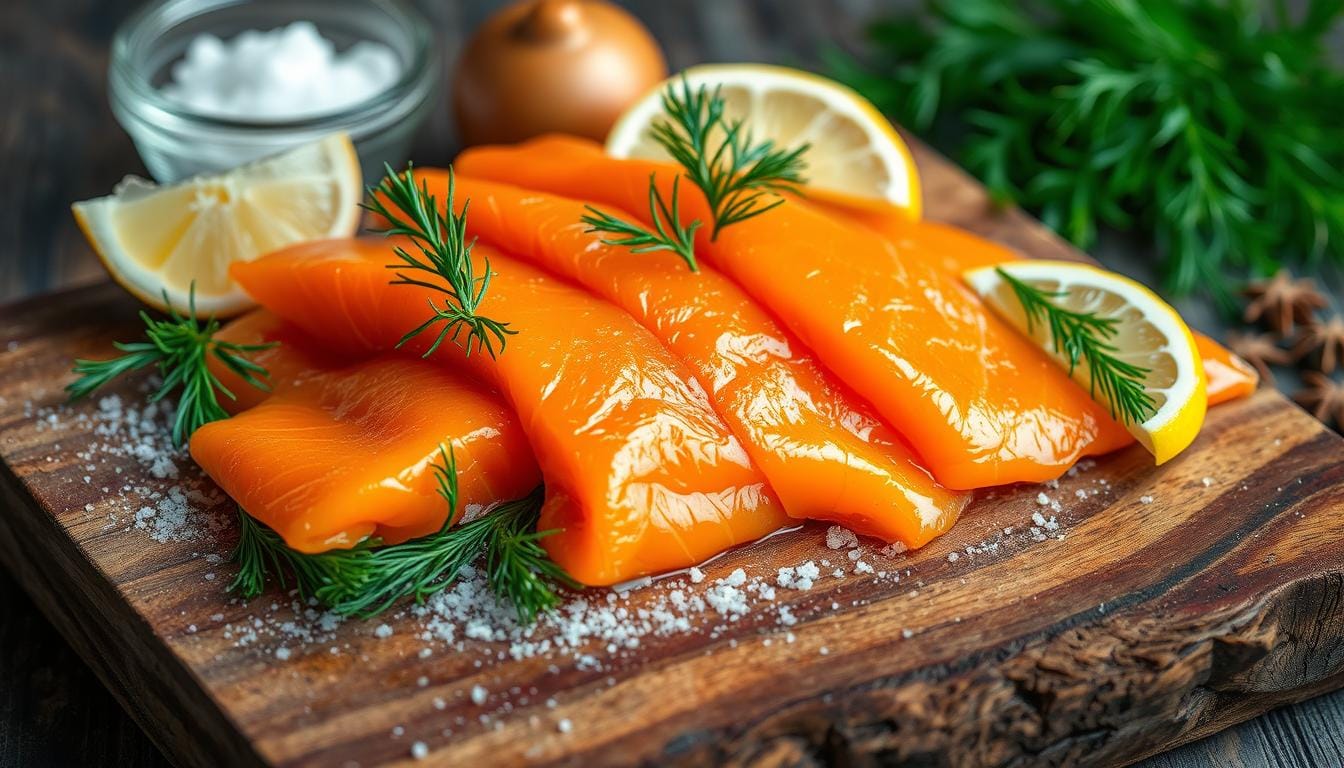Easy Smoked Salmon Dry Brine Recipe For Perfect Fish
I’ve always been fascinated by smoking salmon. It’s amazing how a simple fillet can turn into a gourmet treat. This easy smoked salmon dry brine recipe caught my eye.
Brining and hot-smoking salmon might seem hard, but it’s doable with the right tools. This recipe will guide you through each step. You’ll end up with delicious, flaky smoked salmon perfect for many dishes.
Table of Contents
Understanding the Art of Smoked Salmon
Learning to make smoked salmon is a journey into hot and cold smoking. Hot-smoked salmon cooks at a high temperature, making it firm and flavorful. Cold-smoked salmon, on the other hand, is cured longer and smoked at a lower temperature. This results in a softer texture and a milder smoky taste.
Hot Smoking vs. Cold Smoking Techniques
Hot and cold smoking differ in temperature and time. Hot smoking happens at about 225°F, cooking the fish well and preserving its taste. Cold smoking, at around 90°F, adds a soft smoky flavor without cooking the fish fully.
Benefits of Home Smoking
- Personalization: Smoking salmon at home lets you choose flavors and wood types to your liking.
- Cost-effectiveness: Making your own smoked salmon can save money, especially with quality ingredients.
- Freshness: Homemade smoked salmon is fresher and tastes better, without preservatives.
Why Brining Matters
Brining the salmon before smoking is key. The brine, made of salt, sugar, and water, seasons the fish deeply. It keeps the hot-smoked salmon or cold-smoked salmon moist and flavorful during smoking.
“Brining the salmon before smoking is a crucial step that enhances the final product.”
Essential Ingredients and Equipment
To make delicious smoked salmon at home, you need a few key ingredients and tools. Start with top-quality salmon fillets, preferably wild-caught for the best taste and texture. You’ll also need Diamond Crystal kosher salt, brown sugar, and alder wood chips or pellets to give your salmon a smoky flavor.
You’ll need a good smoker (charcoal, pellet, or electric) for this. Also, have fish tweezers to remove bones, a sheet pan or ziplock bag for brining, and aluminum foil to manage smoke. A probe thermometer helps keep an eye on the salmon’s temperature while it smokes.
| Essential Ingredients | Required Equipment |
|---|---|
|
|
With these salmon smoking ingredients and smoking equipment, you’re ready to make tasty, homemade smoked salmon. It’s sure to wow your family and friends.
“Smoking salmon at home is a rewarding experience that allows you to customize the flavors and textures to your liking.”
Selecting the Perfect Salmon for Smoking
Choosing the right salmon is key for great smoked salmon. You can pick between farm-raised Atlantic salmon or wild-caught king salmon. Farm-raised salmon is fattier, making it rich and buttery. Wild king salmon, on the other hand, is leaner with a vibrant red color and flaky texture.
When picking salmon, look for firm, shiny flesh without fingerprints or tears. It should not smell too fishy. Wild sockeye salmon is also a good choice, offering a leaner texture. Quality frozen salmon can also work well, as long as it’s been properly handled and stored.
Quality Indicators to Look For
- Firm, glistening flesh without fingerprint impressions or tearing
- Minimal “fishy” odor
- Deep, vibrant red color for wild king salmon
- Rich, buttery texture for farm-raised Atlantic salmon
- Firm yet lean texture for wild sockeye salmon
Best Salmon Varieties for Smoking
- Wild king salmon – High fat content, deep red color, extra flaky texture
- Farm-raised Atlantic salmon – High fat content, readily available, more affordable
- Wild sockeye salmon – Leaner but with a firm, consistent texture
“Selecting the right salmon is crucial for achieving the perfect smoked salmon texture and flavor.”
Smoked Salmon Dry Brine Recipe
Making the perfect smoked salmon begins with a dry brine. This method adds a smoky, salty-sweet flavor. It’s simple yet powerful, turning a regular salmon fillet into a delicious treat.
The dry brine mix is 2 parts brown sugar to 1 part kosher salt. This balance enhances the fish’s taste with sweetness and salt. Dry brining is faster than wet brining, making the salmon firmer and denser.
- Start by mixing 2 tablespoons of brown sugar with 1 tablespoon of Diamond kosher salt in a bowl.
- Spread the dry brine over the salmon’s flesh side, skipping the skin.
- Put the brined salmon on a wire rack over a baking sheet. Chill for 5 hours to soak in the flavors.
- Rinse the salmon under cold water to remove extra salt. Dry it with paper towels.
This dry brine method is a key to making the best smoked salmon. It ensures a well-seasoned, delicious fillet, ready for smoking.

“Dry brining is a game-changer for smoked salmon – it seasons the fish deeply and creates a fantastic texture.”
Creating the Perfect Pellicle
Creating the perfect salmon pellicle is key to making flawless smoked salmon. But what is a pellicle, and why is it so important?
What is a Pellicle?
A pellicle is a thin, tacky layer that forms on the salmon’s surface after brining and drying. It helps the smoke stick to the fish. This layer also keeps moisture in, making the salmon tender and delicious.
Drying Time and Conditions
- Start by patting the salmon dry after rinsing off the brine.
- Then, let the salmon air dry in the fridge, uncovered, for 12 hours. This makes the surface tacky and dry.
- Or, use a fan to dry the salmon faster, in 30-60 minutes.
Creating the right conditions for drying the salmon is crucial. It allows the pellicle to form properly. This is essential for the smoke to stick to the fish, giving it a rich flavor.
“The pellicle is a thin layer comprising protein and other components that helps provide a smoky flavor and has preserving properties due to phenols.”
| Meat Type | Minimum Pellicle Time | Ideal Pellicle Time |
|---|---|---|
| Pancetta/Bacon Pork Belly | 1-4 hours | Overnight |
| Trout/Salmon Fillet | 30-60 minutes | 1-4 hours |
| Chicken/Turkey Breast | 2-4 hours | 3-6 hours |
| Seafood | 30-60 minutes | 2-4 hours |
| Mussels/Scallops | 30-60 minutes | 1-3 hours |
| Whole Fish (under 6lb/3kg) | 2-4 hours | Overnight |
Smoking Temperature and Wood Selection
Perfecting smoked salmon requires the right temperature and wood. Keep the smoking temperature at about 225°F for hot-smoked salmon. This ensures it cooks well and stays juicy and flavorful.
Alder wood is the best choice for smoking salmon. It adds a delicate, sweet smoky flavor that complements the fish. Apple or cherry wood also work well, adding a fruity note that enhances the taste.
- Avoid strong-flavored woods like mesquite or hickory, as they can overwhelm the salmon’s delicate taste.
- Soak your wood chips in water for about 30 minutes before adding them to the smoker. This helps to prevent rapid burning and adds extra humidity to the smoking environment.
By keeping the right smoking temperature and choosing the perfect wood for smoking salmon, you can make your homemade smoked salmon truly special. It will be a delightful and authentic experience.
“The key to exceptional smoked salmon is in the balance of temperature and wood selection. Get it right, and you’ll be rewarded with a symphony of flavors.”
Step-by-Step Smoking Process
Getting your salmon ready for smoking is key to making perfect smoked salmon. First, heat your smoker to 225°F. Then, place the salmon fillets, skin-side down, on foil in the smoker.
Monitoring Temperature
Keep an eye on the salmon’s internal temperature. Farm-raised salmon needs to hit 140°F, while wild-caught can go a bit lower. Check the temperature after 30 minutes and keep checking until it’s done, usually 30-60 minutes.
Determining Doneness
Use a dual-channel thermometer to track both the smoker and salmon temperatures. This ensures your smoking salmon process and salmon doneness are spot on.
When the salmon reaches the right temperature, take it out of the smoker. Let it rest for a few minutes. This helps the flavors meld and the texture firm up.
By following these steps, you’ll make delicious smoked salmon. Enjoy it with loved ones or use it in tasty dishes.
Storage and Preservation Methods
Keeping your homemade smoked salmon fresh is key to enjoying it later. Whether you’re storing it for days or months, the right methods matter a lot.
First, let your smoked salmon cool down completely before storing. Once it’s cool, wrap it tightly in plastic wrap or use an airtight container. This way, it stays fresh in the fridge for 3-5 days.
For longer storage, freezing is best. Cut your salmon into portions and seal them in airtight bags or vacuum-seal. Frozen, it can last up to 6 months. Just thaw it slowly in the fridge to keep its taste and texture.
| Storage Method | Shelf Life |
|---|---|
| Refrigerated (Wrapped or Airtight Container) | 3-5 days |
| Frozen (Vacuum-Sealed or Airtight Bags) | Up to 6 months |
With the right storage, your homemade smoked salmon stays delicious all year. Whether you’re storing smoked salmon for a quick snack or preserving salmon for later, these tips will help you enjoy your efforts.

Conclusion
Homemade hot-smoked salmon is a fun and rewarding project. By using this dry brine recipe and smoking method, you can make top-notch homemade smoked salmon at home. Make sure to use quality ingredients, brine right, and control the temperature well for the best taste.
This guide will help you become a pro at salmon smoking tips. You’ll make a delicious, moist, and perfectly textured smoked salmon. It will wow your family and friends. You can enjoy it on its own or add it to dishes for a fancy touch.
Enjoy making your own amazing smoked salmon at home. The mix of the dry brine’s gentle flavors and the smoky taste of King Salmon is a true delight. Be creative, try different wood chips, and let your homemade smoked salmon creations shine.
FAQ
What is the difference between hot-smoked and cold-smoked salmon?
What are the benefits of home smoking salmon?
Why is brining important for smoked salmon?
What are the essential ingredients and equipment for smoking salmon at home?
What are the differences between wild and farm-raised salmon for smoking?
How do you create the perfect pellicle on smoked salmon?
What type of wood is best for smoking salmon?
How do you know when the smoked salmon is done?
How long can you store homemade smoked salmon?
- Party Salmon – Fountain Avenue Kitchen – https://fountainavenuekitchen.com/party-salmon/
- 46 Side Dishes For Salmon Dinners That Are Easy And Delicious – https://www.southernliving.com/food/side-dishes/salmon-sides?srsltid=AfmBOoobb3cKkQ4OdK2W_SRHRiszfZOdknKZFZHo1d6IbC3Z6CmkRwFR
- Smoked Salmon Appetizer Bites – Tastefully Grace – https://tastefullygrace.com/smoked-salmon-cucumber-bites/
- How to Reheat Salmon – Fit Men Cook – https://fitmencook.com/blog/how-to-reheat-salmon/
- Cajun Salmon Bites Recipe – https://domesticdee.com/cajun-salmon-bites-recipe/
- How to Make Salmon Bites – Peanut Butter Fingers – https://www.pbfingers.com/how-to-make-salmon-bites/
- 11 Mistakes Everyone Makes When Cooking Salmon – Food Republic – https://www.foodrepublic.com/1547369/mistakes-everyone-makes-when-cooking-salmon/
- Baked Salmon Bites – Easy and Delicious in 20 Minutes – https://www.anytimesrecipes.com/baked-salmon-bites/
- Game-Changing Air Fryer Bacon Wrapped Salmon Bites – https://littlebitrecipes.com/bacon-wrapped-salmon-bites-in-air-fryer/
- Baked Salmon – https://www.wellplated.com/baked-salmon-in-foil/

